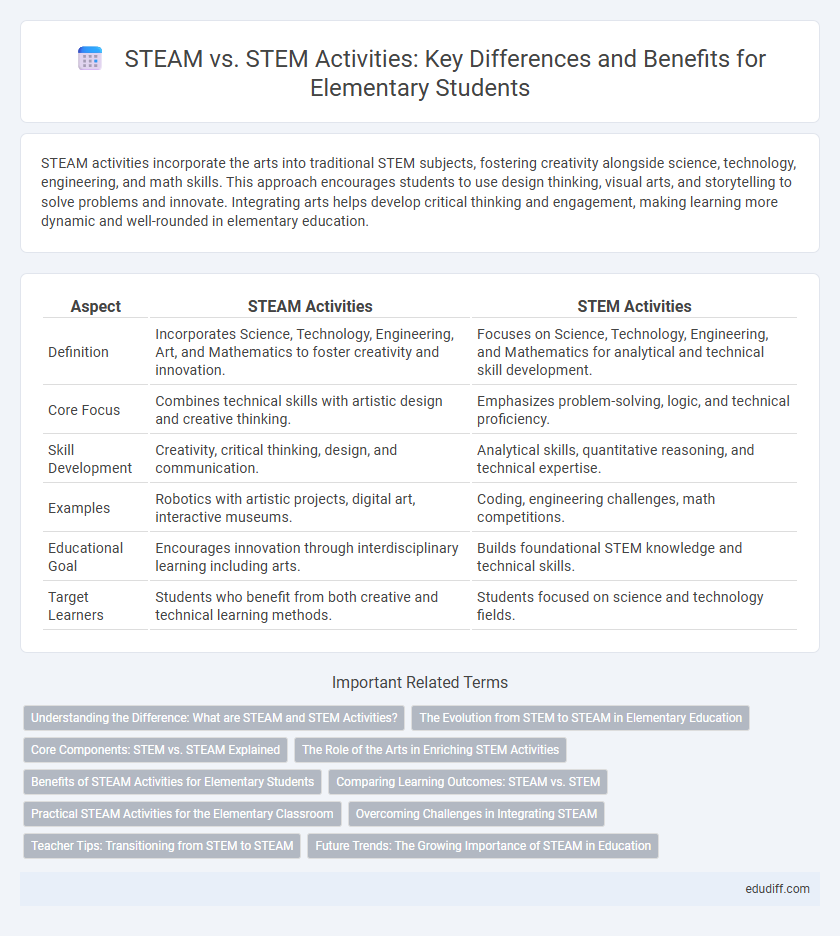STEAM activities incorporate the arts into traditional STEM subjects, fostering creativity alongside science, technology, engineering, and math skills. This approach encourages students to use design thinking, visual arts, and storytelling to solve problems and innovate. Integrating arts helps develop critical thinking and engagement, making learning more dynamic and well-rounded in elementary education.
Table of Comparison
| Aspect | STEAM Activities | STEM Activities |
|---|---|---|
| Definition | Incorporates Science, Technology, Engineering, Art, and Mathematics to foster creativity and innovation. | Focuses on Science, Technology, Engineering, and Mathematics for analytical and technical skill development. |
| Core Focus | Combines technical skills with artistic design and creative thinking. | Emphasizes problem-solving, logic, and technical proficiency. |
| Skill Development | Creativity, critical thinking, design, and communication. | Analytical skills, quantitative reasoning, and technical expertise. |
| Examples | Robotics with artistic projects, digital art, interactive museums. | Coding, engineering challenges, math competitions. |
| Educational Goal | Encourages innovation through interdisciplinary learning including arts. | Builds foundational STEM knowledge and technical skills. |
| Target Learners | Students who benefit from both creative and technical learning methods. | Students focused on science and technology fields. |
Understanding the Difference: What are STEAM and STEM Activities?
STEM activities emphasize Science, Technology, Engineering, and Mathematics to develop problem-solving and analytical skills in elementary students. STEAM activities incorporate Art into the STEM framework, fostering creativity alongside technical knowledge and critical thinking. This integration encourages a more holistic approach to learning by combining logic with artistic expression.
The Evolution from STEM to STEAM in Elementary Education
The evolution from STEM to STEAM in elementary education emphasizes integrating the arts into science, technology, engineering, and math activities to foster creativity and critical thinking. STEAM activities encourage young learners to approach problems with innovation by combining artistic expression with technical skills. This holistic approach enhances engagement and supports diverse learning styles, preparing students for future challenges.
Core Components: STEM vs. STEAM Explained
STEM activities focus on Science, Technology, Engineering, and Mathematics, emphasizing analytical skills and problem-solving through technical subjects. STEAM activities integrate the Arts into STEM, promoting creativity, critical thinking, and innovation alongside scientific inquiry and mathematical reasoning. Incorporating the Arts enhances engagement and develops well-rounded skills crucial for holistic learning in elementary education.
The Role of the Arts in Enriching STEM Activities
Integrating the arts into STEM activities transforms them into STEAM, enhancing creativity and critical thinking in elementary students. Artistic elements like design, storytelling, and visual arts help children understand scientific concepts more deeply and engage their imaginations. This interdisciplinary approach fosters innovation and improves problem-solving skills by combining analytical and creative perspectives in early education.
Benefits of STEAM Activities for Elementary Students
STEAM activities integrate art with science, technology, engineering, and math, fostering creativity alongside analytical skills in elementary students. Incorporating art encourages innovative thinking and enhances problem-solving abilities, promoting a holistic learning experience. These activities improve student engagement, collaboration, and adaptability, essential for developing future-ready skills.
Comparing Learning Outcomes: STEAM vs. STEM
STEAM activities integrate the arts with Science, Technology, Engineering, and Mathematics, promoting creativity alongside critical thinking and problem-solving compared to traditional STEM fields. Research shows that students involved in STEAM develop higher levels of innovation, collaboration, and communication skills, essential for real-world applications. STEM activities emphasize analytical and technical skills, while STEAM encourages a more holistic approach, blending design and artistic expression to enhance cognitive flexibility.
Practical STEAM Activities for the Elementary Classroom
Practical STEAM activities in the elementary classroom integrate science, technology, engineering, arts, and math to foster creativity and critical thinking. Projects like designing paper circuits or creating simple machines with craft materials encourage hands-on learning while enhancing problem-solving skills. These activities support holistic development by blending artistic expression with technical concepts, making complex subjects accessible and engaging for young learners.
Overcoming Challenges in Integrating STEAM
Integrating STEAM into elementary education poses challenges such as limited teacher training and inadequate resources for arts integration. Effective professional development and access to interdisciplinary materials are essential to bridge the gap between STEM and the arts. Schools that invest in collaborative curriculum design and hands-on STEAM activities enhance student creativity and problem-solving skills.
Teacher Tips: Transitioning from STEM to STEAM
Incorporating arts into STEM transforms lessons by fostering creativity and critical thinking, essential for holistic student development. Teachers should integrate project-based learning that combines scientific principles with artistic expression, such as designing visually appealing models or storytelling in coding projects. Emphasizing collaboration and reflection helps students connect technical skills with creative problem-solving, enhancing engagement and innovation in the classroom.
Future Trends: The Growing Importance of STEAM in Education
Integrating arts into STEM education creates STEAM, fostering creativity alongside technical skills, which aligns with future workforce demands for innovation and adaptability. STEAM activities emphasize critical thinking, collaboration, and problem-solving, preparing elementary students for complex real-world challenges. Trends indicate increasing adoption of STEAM curricula to inspire diverse talents and bridge gaps between technology and creativity in early education.
STEAM Activities vs STEM Activities Infographic

 edudiff.com
edudiff.com